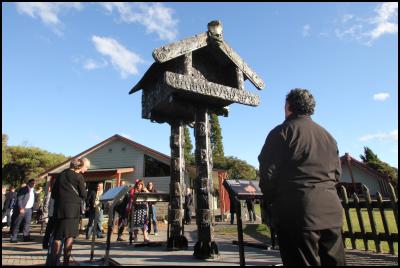Significant bronze storehouse destined for UN
Significant bronze storehouse destined for UN

A significant gift from Aotearoa New Zealand to the United Nations is another step closer with the unveiling of a substantial bronze whatarangi (storehouse) at Te Puia | New Zealand Māori Arts and Crafts Institute in Rotorua today.
The kaupapa (initiative), called Māori Tū, is led by the Iwi Chairs Forum and has been developed as a demonstration of support from Aotearoa New Zealand for the United Nations Declaration for the Rights of Indigenous Peoples. The piece has been temporarily installed at Te Puia while extensive engineering tests are undertaken.
At more than 3.5 metres high and weighing nearly four tonnes, the gift takes the form of a whatarangi, a raised storehouse where the most precious taonga (treasures) of the tribe would traditionally be stored. The bronze whatarangi symbolises safe-keeping, representing the storage and maintenance of tangible and intangible heritage.
Sir Tumu te Heuheu, Chairman of the Iwi Leaders Group which is responsible for the direction of Māori Tū, says one of the key objectives that the gifting of the taonga (treasure) hopes to achieve, is to deepen understanding and to grow a greater social and political consciousness around the significance of the Declaration to both iwi Māori, and to New Zealand.
“Furthermore, we hope that the whatarangi will help to nurture the blossoming of a set of values which will help to inform the development of a unique relationship between indigenous peoples and the United Nations into the future.
“The unveiling of the whatarangi this week is another important step in the process, not just for technical reasons, but also to acknowledge those who have been involved with this kaupapa and to celebrate its completion.”
In particular, Sir Tumu te Heuheu says Rotorua kaumatua, Mauriora Kingi, played a pivotal role in the development of the kaupapa. Mr Kingi died suddenly in 2015.
“Mauriora was not only a graduate of NZMACI, he was a also firm advocate of the protection andperpetuation of Māori art, craft and culture – a mandate which the UN Declaration seeks to protect.”
Sir Tumu te Heuheu says the finer details around the gifting of the whatarangi are being finalised with the United Nations.
Iwi Chairs Forum technical adviser, Karl Johnstone, says Māori Tū has been a significant undertaking for NZMACI, requiring the creation of two whatarangi – a wooden carved original used to cast the bronze work, as well as the final bronze piece.
“The carvers and artists have really pushed the limits of the bronze medium to create the work, whichcaptures the finest elements of carving. The process is a meeting of time honoured practices, including the reductive carving process and the reflective casting process.”
Mr Johnstone says that while many might consider bronze to be contemporary in terms of Māori culture, the skills and techniques have been used for more than 7000 years elsewhere in the world.
Bronze also has a long history in New Zealand, including bronze patu (clubs) which were traded with Māori on Captain James Cook’s second voyage to New Zealand between 1772 and 1775.
“Māori have always adapted to and adopted new technology and while our materials may change over time, the thought processes that underpin the culture remain the same,” he says.
The substantial size and weight of the whatarangi, at just under four tonnes, will require considerable testing and engineering, hence its temporary installation at Te Puia.
“We want to ensure that the whatarangi will stand the test of time once it is installed at the United Nations, so we are undertaking extensive testing on site at Te Puia.
“At the same time, the trial installation provides an important opportunity for iwi Māori and for manuhiri (visitors) to see this unique piece and learn more about its significance and what it represents,” says Mr Johnstone.
Background:
The bronze casting process
As each wooden piece is carved, it is passed to the Foundry for bronze casting. A silicone mould is taken of each carving, with wax poured into the mould and, once set, removed and encased in a ceramic shell.
The wax is melted and removed and the shell is pre-heated, and then the bronze is poured. Once the bronze is set, the ceramic shell is removed, revealing the bronze cast.
Once complete, the whatarangi was constructed from the individual bronze casts.
NZMACI casters have also made use of the unique natural environment in Te Whakarewarewa Geothermal Valley, using water from the sulphur-chloride pools to patina the bronze.
ENDS


 University of Auckland: Tributes Flow For Much Loved Pacific Leader Melegalenu’u Ah Sam
University of Auckland: Tributes Flow For Much Loved Pacific Leader Melegalenu’u Ah Sam NZEI: Ministry Of Education Cuts Will Disproportionately Affect Pasifika
NZEI: Ministry Of Education Cuts Will Disproportionately Affect Pasifika Day One Hapai te Haeata: Call To Action For Young Filmmakers Against The Backdrop Of Funding Cuts
Day One Hapai te Haeata: Call To Action For Young Filmmakers Against The Backdrop Of Funding Cuts Toyota New Zealand: Three Races For Top Three To Decide TR86 Title
Toyota New Zealand: Three Races For Top Three To Decide TR86 Title Wellington City Council: Wellington Is All Action Stations For The Faultline Ultra Festival
Wellington City Council: Wellington Is All Action Stations For The Faultline Ultra Festival Melanie Allison: Local Playwright Casts A Spell Over Hamilton
Melanie Allison: Local Playwright Casts A Spell Over Hamilton